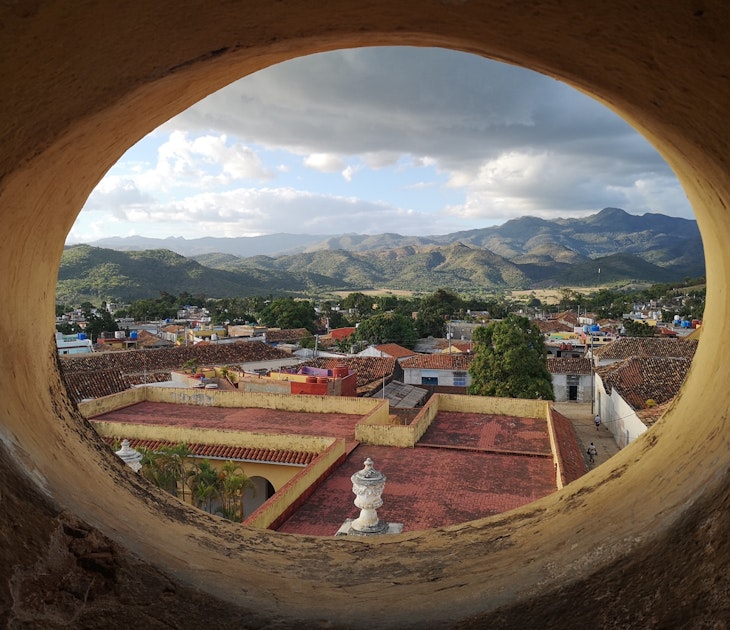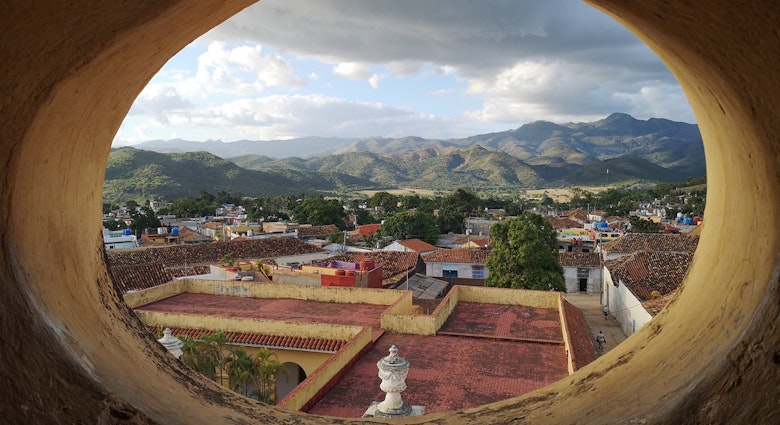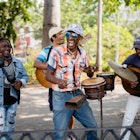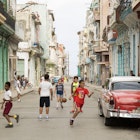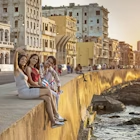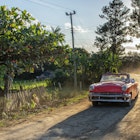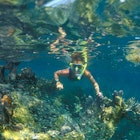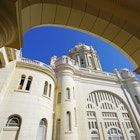The parks dotted around the Cuban capital reflect a city packed with romance and hubbub. Havana's green spaces are where the drama of Cuban life is most vividly played out. At all times of day, you'll see Habaneros dropping by to gossip, slap down dominoes or argue vociferously about baseball.
But it’s not all about crowds and chatter. Away from busy downtown hubs are quieter spots where you can slip away and seek solace amid fountains, orchids and gnarled tropical trees. If you need a green spot to recharge while exploring Havana, here are seven of the best parks to visit in the city.
Parque Central
Best park for people-watching
A diminutive square at the head of the elegant Prado Avenue, Parque Central sits in the shadow of the stately Capitolio Nacional. Anchored by a statue of Cuban national hero, José Martí, dating from 1905, this is Havana’s main hub and transport nexus and it's surrounded by a ring of illustrious theaters, museums and hotels. It’s an ideal place to slow down in the eye of the urban hurricane.
The square has shady trees, an abundance of benches and usually a waiting posse of taxi drivers in guayaberas (casual pleated shirts) busily polishing their Chevrolet Bel Airs. As an alternative to the ballet at the ornate Gran Teatro, take a seat beneath the palms and watch the raw street theater of the esquina caliente (hot corner) where an almost permanent gaggle of baseball fans argue about form, tactics and the latest team defection on a couple of benches close to the Martí statue.

Parque de la Fraternidad
Best park for statues
The Spanish originally planned for the rectangle of land directly south of the Capitolio to be a military parade ground, but Parque de la Fraternidad was remodeled into a public space in 1892 to commemorate the fourth centenary of Christopher Columbus’ landing in the Americas. The manicured gardens you see today were fashioned by French landscape architect, Jean-Claude Forestier, for the Sixth Panamerican Conference in 1928, attended by US President Calvin Coolidge – the last serving US president to visit Cuba.
Forestier’s park was centered around a ceiba tree planted with soil from 28 countries in North, Central and South America and named to signify the fraternidad (brotherhood) between the attending nations. The neatly trimmed lawns are embellished with busts of national leaders, including Simón Bolíver, Benito Juárez and Abraham Lincoln, one of the few depictions of a US president in Cuba.
Today the park is a busy terminus for taxis and metro buses, hence the lines of waiting people. It’s sometimes referred to as “Jurassic Park” because of the rows of battered old American cars used as almendrones (collective taxis).
Parque Lenin
Best park for meeting locals
Laid out between 1969 and 1972 when Cuba was enthusiastically cozying up to the Soviet Union, the 670-hectare Parque Lenin was the ambitious plan of Celia Sánchez, a long-time associate of Fidel Castro. This was one of the few infrastructure projects completed in this economically stagnant era.
As the largest park in Havana, Parque Lenin doesn’t lack physical beauty – check out its handsome old trees and tranquil artificial lake – but the hodgepodge of recreational facilities may seem rather mediocre if you’re used to hanging out in the parks of Miami across the water.
Parque Lenin has a small aquarium with a handful of sad fish, an amusement park with Cuba’s only rollercoaster, and a mini-train that’s rarely working. None of that stops it from being a favorite escape for Habaneros, who load up their antediluvian cars with alcohol, turn up the music and spend many a happy weekend here.
From a tourist perspective, there’s a stirring memorial to Vladimir Lenin, acres of green space to run around in, and an unconventional and inexpensive restaurant called Las Ruínas, built around the mossy remains of an old sugar mill. It's just as much fun to join the Cubans who congregate around the park's cheap parrilladas (barbecues), passing around the rum and dancing their cares away to the incessant beat of reggaeton.
Parque Lenin is 20km (12.5 miles) south of central Havana in the Arroyo Naranjo municipality. The P-13 bus will get you close, but a taxi is more convenient.
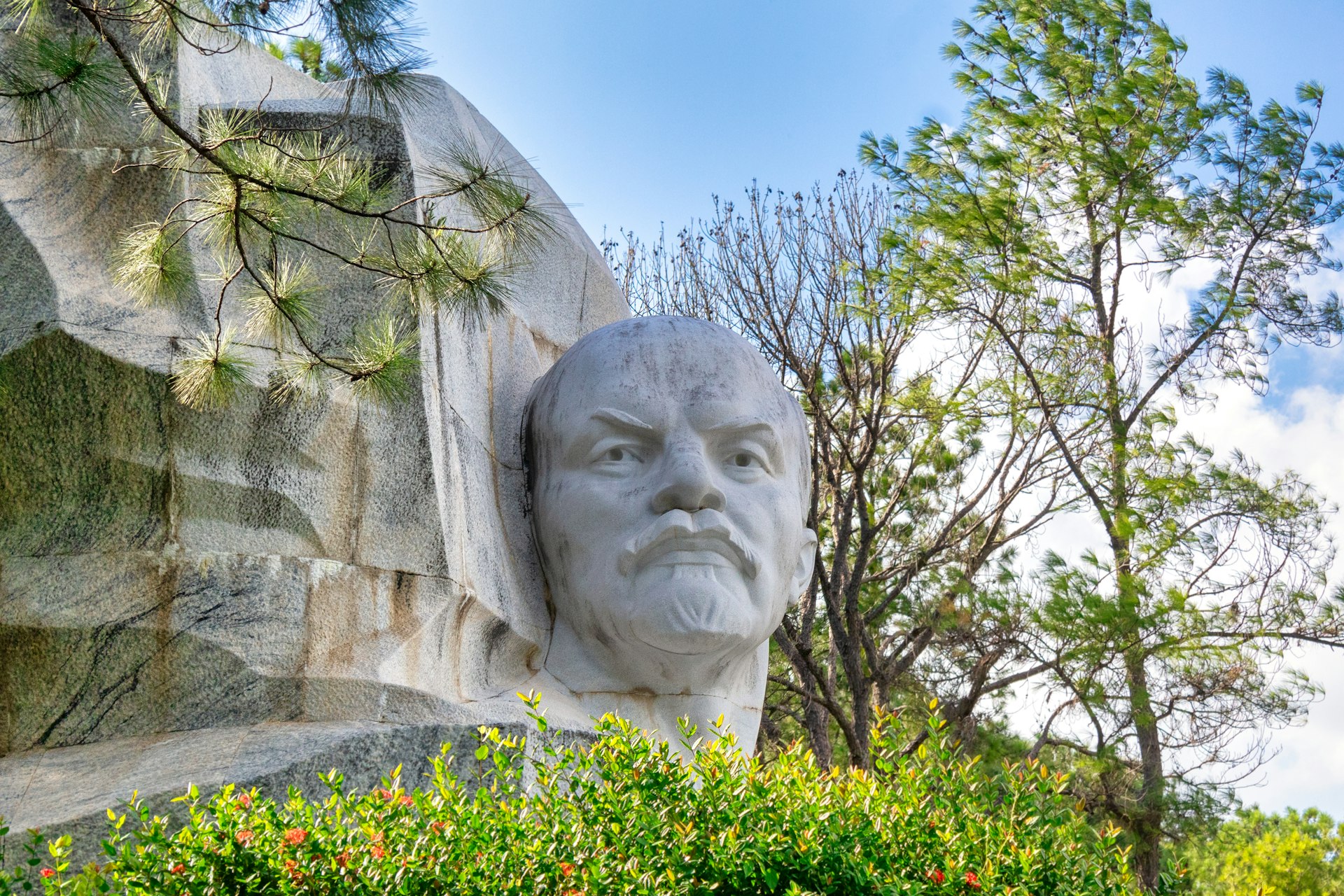
Parque Lennon
Best park for a photo op
From Lenin to Lennon... If you’ve had a hard day’s night on the tourist trail and fancy a bit of R&R in a leafy city square, decamp to Parque Lennon in Vedado where you can slump down on a park bench and have your photo taken next to a life-sized statue of one of the greatest songwriters of the 20th century.
In reality, Lennon never set foot in Cuba, and the Cuban government banned the music of The Beatles in 1964 on the pretext that it could corrupt the country’s youth. Fidel Castro had a change of heart in 2000 – at the statue’s official unveiling, he gave a speech extolling Lennon as a “dreamer” whose dreams he “shared completely.”
Depicting the musician in his late-60s hirsute period, the bronze statue is the work of Cuban artist José Villa Soberón, who has also sculpted likenesses of two famous Ernestos that Cuba has taken to its heart: Guevara and Hemingway.
The statue sits in a pleasant if unremarkable block-sized park that was formerly known as Parque Menocal, in honor of Cuba’s third president. The state-run, Beatles-themed bar Submarino Amarillo (Yellow Submarine) occupies the park’s southeast corner.
Gran Parque Metropolitano
Best park for wilderness
Havana’s undomesticated but seductive Gran Parque Metropolitano is half-hidden along the forested banks of the Almendares River, which separates the neighborhoods of Vedado and Playa. Originally intended to be part of a chain of interlocking green spaces, the park was conceived by Jean-Claude Forestier in the 1920s. However, it only came into being in 1959, when the new Castro government created Parque Almendares – a cluster of modest amusements including a mini-golf course, an amphitheater and some decidedly non-scary model dinosaurs – near the river mouth.
Today, Parque Almendares has been combined with the impressive sprawl of urban greenery known as the Bosque de la Habana (Havana Forest) to create the 700-hectare Gran Parque Metropolitano. In contrast to the tamed precinct of Parque Almendares, the bosque is a potpourri of vine-draped banyan trees and winding riverside paths where Santería (an Afro-Cuban religion) rituals are often performed.
At weekends, Gran Parque Metropolitano is popular with wedding photographers and families. A dawdling clean-up campaign has been ongoing since the late 1990s, but stray dogs and sporadic litter can still be an issue.

Quinta de los Molinos
Best park for plants and flowers
Sitting like a country estate in the middle of the city, the gated Quinta de los Molinos complex is named for the water-powered mills that once stood on the site, grinding tobacco to make snuff. After the demise of the snuff industry in the 1820s, the land became a botanical garden, and in 1835, an eclectic villa was added to serve as a summer residence for Cuba’s Spanish governors.
The villa today has strong associations with Cuban War of Independence hero, Máximo Gómez, who resided here briefly at the turn of the 19th century. A small museum tells his story, but the real attraction is the exuberant garden, speckled with orchids, butterflies, colorful polymita snails and 160 different tree species, including thick-set ceibas that are more than two centuries old.
The grounds were partially re-opened several years ago after being inaccessible for decades, and the museum was inaugurated in 2020. Entry is by guided tour only; check the opening times on the gate.
Parque de los Enamorados
Best park for history
A park with several competing names, this shady spot at the ocean-facing end of the Prado is known as Parque de los Mártires (Martyrs Park) and Parque de la Cárcel (Prison Park), but most alluringly as Parque de los Enamorados (Lovers Park).
This last moniker has merit. A definite air of romance emanates from the shady trees and trickling fountain anchored by a curvaceous female statue by Cuban sculptor Rita Longa. The park's history, however, is less idyllic. In colonial times, a notorious prison stood on the site and inmates – including celebrated patriots such as José Martí – were forced to endure hard labor in the nearby San Lázaro quarry.
When the prison was demolished in 1939, two tiny cells and a chapel were left as a memorial. The park is also overlooked by a monument to eight Cuban medical students who were executed by the Spanish in reprisal for allegedly desecrating the tomb of a Spanish journalist in 1871. The act came at the height of Spanish-Cuban tension during the Cuban War of Independence, and the students – the youngest of whom was 16 – have long been viewed as martyrs.
You may also like:
7 free things to do in Havana
Top 5 day trips from Havana
Why female Cuban professionals are leaving their careers to become artists


